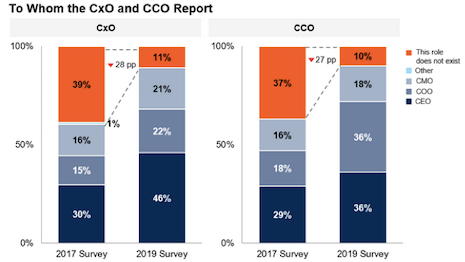- About
- Subscribe Now
- New York,
February 13, 2020

 Creation of chief experience officers and chief customer officers has blurred lines of authority and responsibility with departments, particularly marketing. Image credit: Gartner
Creation of chief experience officers and chief customer officers has blurred lines of authority and responsibility with departments, particularly marketing. Image credit: Gartner
As customer experience becomes a key determinant for a shopper to engage with a brand, marketers are under pressure to treat CX as a serious discipline under leadership of a single individual.
A new Gartner Customer Experience Management Survey revealed that last year only 11 percent of companies did not have a chief experience officer (CXO) and only 10 percent lacked a chief customer officer (CCO). This is up from 35 percent of companies that had only one of those titled executives on board in 2017.
“There has been significant growth in the presence of CXOs and CCOs or equivalents in many organizations over the last two years,” said Augie Ray, vice president and analyst at Gartner for Marketers, in the report. “However, these roles rarely report to CMOs despite marketing taking control of more CX initiatives.”
Companies are dedicating budgets to this discipline and many are hiring customer experience (CX) officers apace, according to Gartner.
CX leadership on the rise
As customer experience takes a more central role in business strategy, companies are giving the responsibility to several different departments ranging from marketing, IT, customer service, operations, sales and standalone CX departments.
Gartner found customer service budgets and initiatives are also beginning to shift into the marketing department.
“As marketing continues to take on a larger role in CX, marketing leadership faces a potential challenge coordinating companywide CX,” Mr. Ray said.
“CMOs and marketing leaders responsible for aspects of their organization’s CX must ensure that roles are understood, redundancy and conflict are minimized, and collaboration is prioritized,” he said.
For marketing departments to create a successful customer experience, Gartner has created a list of best practices and recommendations. These guidelines are designed to help CMOs and other CX leaders take action and ensure their efforts will be successful.
Establish clear lines of responsibility and authority for everyone involved in CX. It is beneficial if several departments focus on the customer experience.
An online experience may differ from an in-store experience, which is also unique from a mobile experience.
To ensure that each channel delivers a good customer experience, a company must include the input from each team under a unified leader.
Cross-channel contributions with a strong cross-functional governance will help avoid conflicting CX strategies and programs.
Ensure that all CX leaders meet often, share data, discuss issues, review vendors and avoid confusion over accountability.
Broaden marketing measures. Brands that aim to succeed at customer experience should broaden their key performance indicators and include both short-term and long term-metrics that evaluate customer experience programs.
CX should deliver beyond immediate goals such as awareness, inbound traffic and conversion, and also deliver long-term outcomes including improved customer satisfaction, reduced churn, increased lifetime value and referrals.
These goals should be designated by not only internal expectations, but by the customers’ definition of success.
Additionally, create metrics and business goals that meet customer expectations.
Share your thoughts. Click here